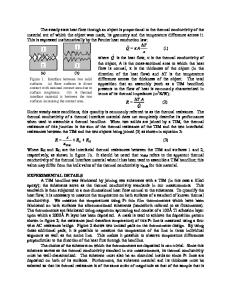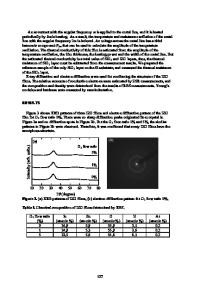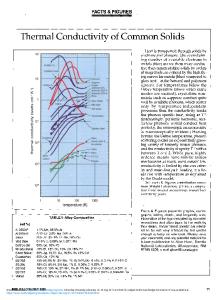Thermal conductivity and thermal diffusivity of selected oxide single crystals
- PDF / 81,329 Bytes
- 5 Pages / 612 x 792 pts (letter) Page_size
- 62 Downloads / 372 Views
J.E. Graebner Bell Labs, Lucent Technologies, Murray Hill, New Jersey 07974 (Received 28 August 2000; accepted 8 December 2000)
Values for the thermal conductivity and the thermal diffusivity D of four oxide single crystals were obtained. Near room temperature, the values for (W cm−1 K−1) and D (cm2 s−1) are as follows: LaAlO3, ⳱ 0.115, D ⳱ 0.0446; NdGaO3, ⳱ 0.068, D ⳱ 0.0197 for one structural orientation, and ⳱ 0.059, D ⳱ 0.0195 for an orthogonal orientation; (LaAlO3)0.3–SrAl0.5Ta 0.5O3, ⳱ 0.051, D ⳱ 0.0133; and, ScAlMgO4, ⳱ 0.062, D ⳱ 0.0229. The relative standard uncertainties in these values are ±10% (1 ). These values allowed us to calculate the specific heat of the materials. The thermal conductivity was measured by a dc heated bar method, and the ˚ ngstro¨m’s method. thermal diffusivity was measured by a modification of A
I. INTRODUCTION
II. THEORETICAL CONSIDERATIONS
There is considerable interest in new single-crystal materials because of the need for lattice-matching substrates for growing epitaxial thin film layers for a variety of photonic and electronic applications. In applications where heat transport is important, the values of thermal conductivity, , or thermal diffusivity, D, of these materials are needed for modeling the thermal performance of devices made with these substrates. In the present work, we report values of thermal conductivity and thermal diffusivity of four single-crystal ceramic materials that can be used as substrates for growing epitaxial films, especially high-Tc superconducting films: lanthanum aluminate–LaAlO 3 , neodymium gallate–NdGaO3 in two crystalline orientations, LSAT– (LaAlO3)0.3–SrAl0.5Ta0.5O3, and SCAM–ScAlMgO4. The thermal conductivity was measured with the dc heated bar technique1 and the thermal diffusivity was ˚ ngstro¨m’s method2,3 measured with a modification of A that uses scanning photothermal radiometry.4 The thermal conductivity is related to the thermal diffusivity D ⳱ /C, where is the mass density and C is the heat capacity per unit mass. The independent determination of both thermal parameters enables us to calculate the specific heat of the four ceramic materials because their densities were previously known.
The techniques used in the present work are based on the one-dimensional (1D) heat diffusion equation for a harmonic source,
a)
Permanent address: Nuclear Sciences Institute Vinca, Belgrade, Yugoslavia. b) Permanent address: Instituto de Fı´sica, UFRGS, Porto Alegre, RS, Brazil. 678
http://journals.cambridge.org
J. Mater. Res., Vol. 16, No. 3, Mar 2001 Downloaded: 13 Jun 2014
d2T共z兲
+
冉
冊
i − h T共z兲 = 0 D
, (1) dz where T(z) is the complex temperature along the specimen surface at position z, is the angular frequency, and h is a term to account for heat loss to the surroundings by thermal radiation or by convection and conduction through the ambient gas. 2
A. DC heated bar method
In the dc limit ( ⳱ 0) with a steady flow of heat through a long bar, the solution of Eq. (1) is a catenary, T(z) ⳱ {T1 sinh[(
Data Loading...











